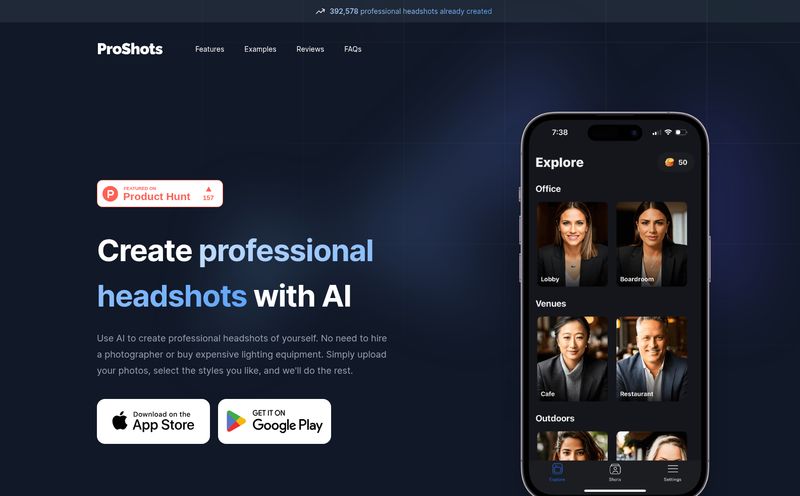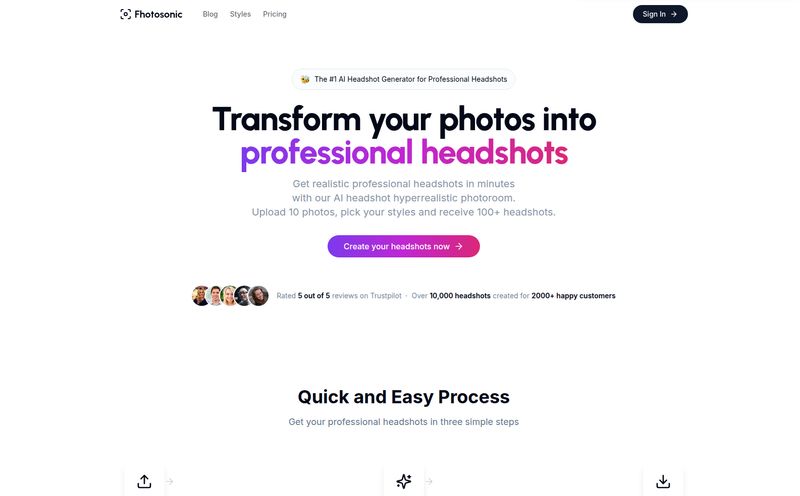Remember that phase, maybe a year or so ago, when your entire Instagram feed suddenly looked like it was populated by astronauts, fantasy elves, and pop-art versions of your friends? Yeah, me too. As someone who lives and breathes SEO and digital trends, I watched the AI avatar craze explode with a mix of professional curiosity and, I'll admit, a little bit of FOMO. Everyone was doing it. And at the heart of this trend were tools like Arti.pics.
The promise was intoxicatingly simple: feed an AI a few of your regular, boring selfies, and in return, get a whole gallery of epic, stylized versions of yourself. So, I decided to take a closer look, put on my reviewer hat, and see what the fuss was all about. But when I went to check it out again recently… well, that's where our story takes an interesting turn.
What Exactly Was Arti.pics Supposed to Do?
At its core, Arti.pics was a straightforward AI-powered avatar generator. The concept wasn't complicated, which was its main appeal. You didn’t need to be a tech wizard or a graphic designer. You just needed a handful of photos of your face and a little bit of patience.
The deal was this: you upload your pictures, and the platform’s AI model gets to work, training itself on your likeness. Think of it like giving your photos to a mysterious but very fast street artist who promises to come back in an hour with a portfolio of you as a space pirate, a stoic Roman statue, and a character from an anime. The platform boasted it could generate over 200 unique avatars for you in a ton of different styles. For anyone looking to spice up their social media profile picture or just have a bit of fun, it sounded pretty great.

Visit Arti.pics
The Process of Creating Your AI Alter Ego
The user experience was designed to be dead simple. It was basically a three-step process: pay, upload, and wait. That's it.
From my experience with similar platforms, the key to getting good results is always in the photo selection. You can't just throw in a few grainy group photos and hope for the best. For these AI's to work their magic, they need clear, well-lit shots from different angles. A few straight-on, a few profiles, maybe one with a different expression. You're essentially giving the AI a 3D model of your head to work with, but with 2D images. The better the input, the better the output. It’s a classic GIGO situation—Garbage In, Garbage Out.
Once you handed over your photos, it became a waiting game. The AI would “train” on your images, a process that could take a little while. This is the black box moment of the whole thing. Your pictures are sent into the digital ether, and you just have to cross your fingers that what comes back is amazing and not, you know, nightmarish.
Lets Talk Money - The Arti.pics Pricing Model
Here’s something I actually appreciated about their model: it was simple. In a world of confusing subscriptions and tiered feature lists, Arti.pics went with a one-and-done payment.
| Service | Features | Price |
|---|---|---|
| AI Avatar Generation | 200+ unique avatars in various styles | $29 (one-time payment) |
For $29, you get a batch of over 200 images. That breaks down to less than 15 cents per avatar. When you put it that way, it doesn't sound too bad. Some people spend more on a fancy coffee. However, the big catch here is the lack of a free trial. You couldn’t just generate one or two to see if you liked the style; you had to commit the full $29 upfront. That’s a bit of a gamble, especially when you can’t be sure if you'll love the results.
The Good, The Bad, and The... Weird
Like any tool, Arti.pics had its ups and downs. Based on its feature set and the general consensus from when it was active, here’s my breakdown.
What I Liked About the Idea
The sheer volume is the first thing that stands out. Getting 200+ images is a lot. You’re almost guaranteed to find at least a few that you absolutely love. The variety of styles was also a huge selling point. You weren't just getting slightly different versions of the same photo; you were getting a whole new artistic identity pack. And let's be honest, the core idea is just fun. It taps into that universal curiosity of seeing ourselves in a different light. It’s pure, unadulterated digital play.
Where It Falls Short (And Why You Should Care)
First off, the no-free-trial thing I mentioned is a biggie. I'm always wary of services that require full payment before showing you what they can do. Another major drawback was the finality of it all. Once you uploaded your photos and started the process, that was it. No going back. If you realized you uploaded a blurry photo, too bad. You just had to hope for the best.
Then there's the infamous AI weirdness. These models are incredible, but they're not perfect. Users of these types of services often report getting back images with distorted faces, mismatched eyes, or the classic six-fingered hand. While some of these can be funny, when you've paid for a service, you expect a certain level of quality. The risk of getting some duds in your batch of 200 was definitely real.
The Elephant in the Room - The Case of the Missing Website
So, this brings me to the weirdest part of this whole review. I went to the Arti.pics URL to get a fresh look, and what did I find? A stark white page with a simple message: “404 Page not found.”
Vanished. Gone. Poof.
I did a little digging, and it seems the site has been offline for a while. There's no redirect, no message explaining what happened. It just disappeared. What does this mean? It could be anything. Maybe they got acquired by a larger company. Maybe they rebranded under a new name. Or maybe, just maybe, the AI avatar trend was a bubble, and Arti.pics was one of the casualties when it popped. It's a classic example of the fast-paced, almost brutal nature of the tech world. One day you're the talk of the town, the next you're a 404 error. It’s a sobering reminder for anyone in the digital space that trends, and the tools built on them, can be fleeting.
So, Should You Still Try to Find Arti.pics?
Well, you can't, not right now anyway. But the question is, is the concept worth pursuing with other tools? I’d say yes, but with caution. The idea of a one-time payment for a big batch of avatars is still appealing, especially compared to some of the subscription models out there.
If you're looking for an alternative, tools like Lensa AI (which really kickstarted the trend), Fotor's AI Generator, or YouCam Perfect offer very similar functionality. Many of them have refined the process and are still actively supported and updated. My advice is to look for one that offers some kind of preview or a smaller, cheaper starting package. Don't jump in headfirst without testing the water.
Personally, the mystery of Arti.pics serves as a great lesson. The AI gold rush is creating incredible tools, but it's also a bit of a Wild West. It's exciting, but you have to be smart about where you spend your money and who you trust with your data (or in this case, your face).
Frequently Asked Questions
How much do AI avatars usually cost?
The price varies wildly. Some, like Arti.pics, used a one-time fee model ($20-$30). Others, like Lensa AI, use in-app purchases where you buy packs of avatars. There are also some free versions, but they are often lower quality or heavily watermarked.
Is it safe to upload my photos to AI avatar tools?
This is a major concern. You are handing your biometric data over to a company. It's super important to read the privacy policy. Reputable companies will state that they delete your photos and the trained AI model from their servers after a short period. If a tool's policy is vague, I'd steer clear.
Why do AI-generated images sometimes look strange?
AI models are trained on massive datasets of existing images. Sometimes they get confused, especially with complex details like hands and eyes. The AI doesn't 'understand' a hand; it just knows what patterns of pixels usually form a hand-like shape. When it gets it slightly wrong, you get those infamous extra fingers or weirdly bent wrists.
What are the best Arti.pics alternatives?
Some of the big names that are still very active include Lensa AI, Fotor's AI Headshot Generator, Epik, and YouCam Perfect. Each has slightly different styles and pricing structures, so it's worth checking out a few to see which fits your vibe.
Can I use AI avatars for my professional profile?
You can, but it depends on the style and your industry. A photorealistic, professional-looking AI headshot might work great on LinkedIn. A cartoon astronaut version? Maybe save that for Discord or Instagram. It's all about context and knowing your audience.
Final Thoughts
Arti.pics seems to have been a simple, effective, if flawed, player in the AI avatar game. Its straightforward pricing and massive output were definite pluses. But its no-trial policy and the inherent risk of AI weirdness were significant drawbacks. Its current disappearance is a curious case, a ghost in the machine that reminds us just how quickly the digital landscape can change. Here today, 404 tomorrow.
The tech itself is still incredibly cool and full of potential. If you’re thinking of creating an AI version of yourself, go for it! It's a blast. Just be a savvy consumer: look for current tools, read the reviews, understand the privacy policy, and maybe start with a tool that lets you dip your toes in before you dive.



